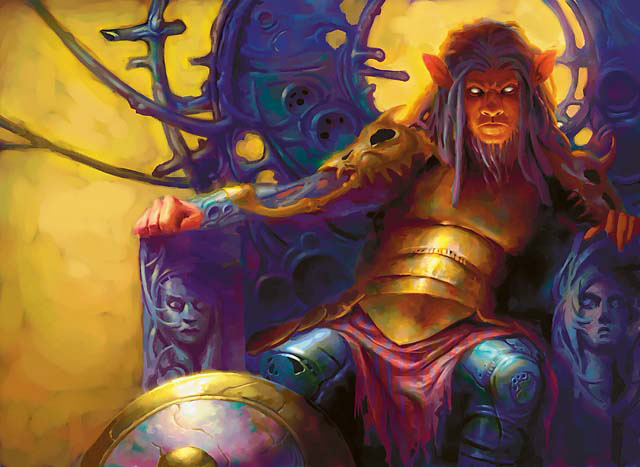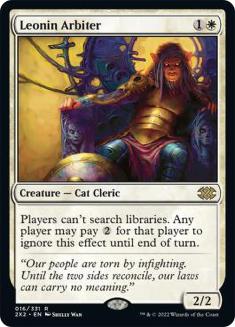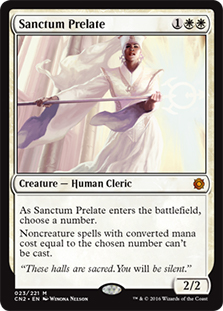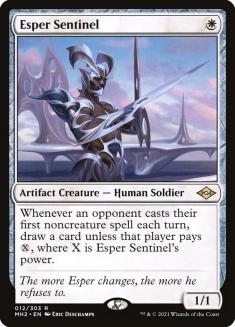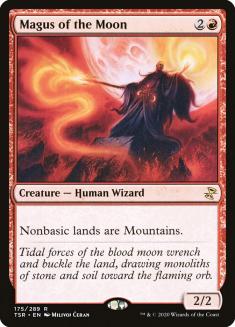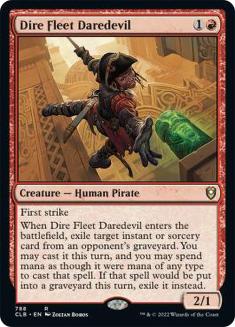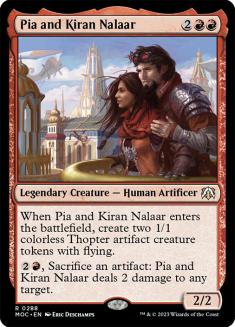Modern has plenty of decks with loyal followings, but perhaps no such group is so dedicated as Death & Taxes players. It’s one of the older decks in the format, and I don’t think it has ever been a clear Tier 1 strategy. It seemed like it might finally break through when Skyclave Apparition entered the format last fall, but once again it faded back to the fringes of the metagame.
But Death & Taxes players soldier on, fighting the good fight with their mediocre collection of annoying white creatures, sometimes splashing a color for some spice. It’s truly inspiring to see how devoted they are.
And after so many years of grinding out games with an underpowered deck, I have some good news: With the arrival of Modern Horizons 2, I believe that Death & Taxes decks will be a major player in the Modern format moving forward. The archetype got a ton of new tools and it has reached a critical mass that has put the deck on par with the most competitive decks in the metagame.
There’s Always a But…
But it’s not all good news. Part of pushing the deck’s power level up to a competitive level is getting rid of the underpowered cards that have been staples of the archetype since its inception. That means moving on from Leonin Arbiter.
No single card defines this archetype more than Leonin Arbiter. The synergy with Ghost Quarter, Field of Ruin, and Path to Exile has been the engine that made the deck run. This has been an aggressive deck with a strong mana denial plan that paired nicely with the mana advantage provided by Aether Vial. Destroying a land or two made Thalia, Guardian of Thraben and other tax effects that much more difficult to play through, allowing you to close the game even with an undersized assortment of creatures.
But if we’re being honest, Leonin Arbiter has also held the deck back. WIthout drawing Ghost Quarter you almost never got immediate value from the card, and even that was no guarantee if your opponent had mana open for a Lightning Bolt or Fatal Push. As the disruption in Modern has increased in power level, the value of two-mana creatures that don’t provide immediate value, like Dark Confidant for example, has decreased, and Leonin Arbiter is no exception.
Sometimes you can catch your opponent without an answer and several fetchlands in hand, but those times are few and far between, especially against a prepared opponent who knows to play their fetchlands early in the matchup.
Leonin Arbiter’s inconsistent impact wouldn’t be as much of a problem if the opportunity cost of playing it weren’t so high. Fetchlands are among the most powerful cards ever printed, and not being able to utilize them yourself is rarely better than stopping your opponent’s. With all the colorless lands required to fill out the land destruction package, it was a stretch for Death & Taxes players to even play a second color, resorting to playing weak dual lands to fill out their manabase. And playing more than two colors has been impossible. This made the archetype less adaptable since it wasn’t able to access as much of the Modern card pool as most other strategies.
The New Tools
From Modern Horizons to Modern Horizons 2, many new cards have been printed that help Death & Taxes decks compete in a more normalized game. Giver of Runes is the one-drop the deck always lacked. Stoneforge Mystic is a premier-level threat and Equipment like Sword of Fire and Ice helps your disruptive creatures attack and block profitably in the face of bigger creatures. Skyclave Apparition gave the deck much-needed removal for not only early creatures but also pesky cards like Wrenn and Six and Oblivion Stone. And now you have access to even more of those kinds of cards in Sanctum Prelate, Solitude, and Esper Sentinel.
Leonin Arbiter was a necessary evil when Death & Taxes players had few removal options past Path to Exile and little in the way of card advantage or a clock. Leaning into the mana denial plan was the best they could do. That’s no longer the case. So there’s little reason to keep sacrificing so much in deck construction to play Arbiter when you can just play better cards and still have a robust disruption package.
Building Around Blink Synergies
If you’re going to transition towards a more typical strategy, the main priority will be how to generate card advantage. White creatures have historically been rather poor at doing so outside of Stoneforge Mystic, but that has changed with the printing of Yorion, Sky Nomad and Ephemerate. These are powerful cards at a good rate that allow you to leverage the various enters-the-battlefield triggers on your creatures to gain much-needed card advantage.
In addition, both have attributes that lead them to function even better in this style of deck. Yorion plays very well with Aether Vial, letting you put the card into your hand and then onto the battlefield in one turn, even if you don’t have access to eight mana. Then you can use the Yorion trigger to reset your Aether Vial so it doesn’t sit uselessly on five counters for the rest of the game. With any substantial battlefield presence, a turn like this can put you very far ahead.
Ephemerate pulls double duty by also acting as a protection spell for your key creatures. A disruptive creature like Sanctum Prelate becomes that much more difficult to remove when you can protect it for one mana and then follow it up on the rebound to gain card advantage with a Stoneforge Mystic, Solitude, or even Wall of Omens. You’re happy to have access to a card that can play that role, but playing something like Gods Willing would be too narrow, so Ephemerate is perfect.
The Future Is Already Here
Death & Taxes lists have been incorporating Yorion as a companion for a while now, but they hadn’t made the full-blown switch to building around blink synergies rather than mana denial. But the very first Modern Challenge on Magic Online saw someone take that plunge, and they were rewarded with a first-place finish:
Creatures (35)
- 3 Meddling Mage
- 4 Flickerwisp
- 4 Stoneforge Mystic
- 4 Thalia, Guardian of Thraben
- 3 Spell Queller
- 4 Watcher for Tomorrow
- 2 Charming Prince
- 3 Skyclave Apparition
- 4 Elite Spellbinder
- 4 Solitude
Planeswalkers (3)
Lands (15)
Spells (27)

Even without Leonin Arbiter, this deck has plenty of disruption. Meddling Mage, Skyclave Apparition, Solitude, Spell Queller, and Elite Spellbinder all work nicely with Ephemerate and Yorion. Teferi, Time Raveler is there as both a powerful card in its own right and a way to ensure that your blink tricks resolve unopposed.
The importance here of Solitude can’t be understated because it allows the deck to move past Path to Exile, which concedes both tempo and card advantage and is a weak answer to early creatures. For a lesser cost of card advantage and life, Solitude also ensures that you don’t fall behind early, but in combination with Ephemerate or when cast later in the game, it generates card advantage rather than conceding it. For this reason Solitude will be the most important addition to Death & Taxes decks from Modern Horizons 2.
As for the disruption suite, the impressive part is that this is an 80-card deck and there are so many other options you could play. Esper Sentinel is a cheap source of card advantage that plays well with Thalia, Guardian of Thraben and other tax effects. Unsettled Mariner is another such tax effect. Rishadan Dockhand can offer some mana denial in a post-Arbiter universe if you’re scared of Tron decks without Ghost Quarter. Sanctum Prelate is excellent against Prowess strategies that lean heavily on one-mana spells, and it can also stop the resurgent Living End or other cascade shenanigans.
This isn’t a criticism of the above list, but an acknowledgement that the set of possibilities is much larger for this deck than before. That’s a good problem to have because it allows you to be flexible and play whichever disruption creatures are most appropriate for a given metagame. But the fact that this deck still took down a Challenge on a weekend when no one knew what exactly to expect suggests that the card quality is still high enough to carry you even when your particular list isn’t optimally positioned for that weekend.
I will say that I’m not fond of the manabase in this list, since it seems to be ported over from a list with Leonin Arbiter. Twelve blue sources plus some unreliabl eCavern of Souls isn’t enough in an 80-card list, and you can easily play a Hallowed Fountain or two and some white fetchlands to ensure your manabase is smooth and still relatively painless. I’d also consider some other utility lands, whether Field of Ruin to help against Tron, Moorland Haunt for more attrition help, or some white Horizon lands to mitigate mana flood. There are plenty of options and it’ll take some time for a defined post-MH2 metagame that you can target to materialize. Right now I’d suggest trying a range of cards so you can learn as much as possible and be prepared when that metagame emerges.
The Potential of Imperial Recruiter
Of course blue isn’t the only color that offers some intriguing options for Death & Taxes players. Recruiter of the Guard is a staple of Death & Taxes in Legacy, and its older cousin, Imperial Recruiter, is now in Modern thanks to MH2. It’s another enters-the-battlefield trigger to reuse with Ephemerate and Yorion, but one that lets you play a toolbox of disruptive creatures in the maindeck, thus offering even more flexibility against an evolving metagame. Here’s my current list:
Creatures (36)
- 4 Imperial Recruiter
- 1 Magus of the Moon
- 4 Flickerwisp
- 4 Stoneforge Mystic
- 4 Wall of Omens
- 3 Thalia, Guardian of Thraben
- 1 Pia and Kiran Nalaar
- 1 Sanctum Prelate
- 1 Dire Fleet Daredevil
- 4 Giver of Runes
- 1 Charming Prince
- 4 Skyclave Apparition
- 4 Solitude
Lands (23)
Spells (21)

Sanctum Prelate and Magus of the Moon are the main disruptive tutor targets, with Magus being particularly strong because of its ability to completely lock your opponent out of the game. Dire Fleet Daredevil and Pia and Kiran Nalaar are great for attrition games, especially when you can blink them multiple times. You don’t need much more than that since the normal lineup of creatures is so strong, but moving a Sanctifier en-Vec or Phyrexian Revoker to the maindeck could be appropriate in metagames where they’re particularly valuable.
Lightning Bolt is the other attraction to red, giving the deck another premier removal spell, and in particular one that is at its best on the opening turns. As good as Solitude and Skyclave Apparition are, they aren’t the best answers to Monastery Swiftspear or Giver of Runes, so it’s nice to have a removal spell that is without sacrificing card quality.
Four pieces of Equipment may be too many, but I like Kaldra Compleat in a deck where you can protect Stoneforge Mystic for a turn with Giver of Runes or a discard spell. The impact of the card is incredibly high, and having a fourth piece lets you more readily take advantage of your blink effects. Playing four cards in an 80-card list is the same density as three in a 60-card list, so you shouldn’t flood on Equipment more often than you would in a typical list.
It can be difficult letting go of a card that has been so integral to one of your favorite decks for so long, but much like Jund Midrange players had to cut Dark Confidant, so too must Death & Taxes players cut Leonin Arbiter from their decks. It’s just not where the power lies when it comes to disruptive creatures in Modern. But you can take solace in the fact that by moving on from land destruction, the resulting deck will be much stronger and better-equipped to compete not only in the current Modern metagame, but in the future as the metagame continues to evolve.
Death & Taxes will be more powerful and more versatile than ever before.

